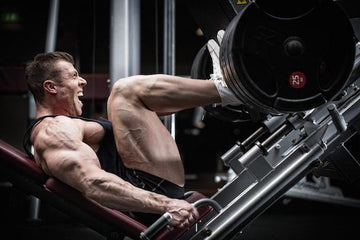V-Taper Shoulder Training
Table of Contents
V-Taper Shoulder Training
By Stephane Cazeault, The Poliquin GroupTM
Speaking at the 2015 Arnold Classic, Arnold remarked that in his era bodybuilders had beautiful V-tapered physiques characterized by wide shoulders tapering down to small waists. In contrast, he said, too many of today’s champions have physiques that are “bottle shaped” and changes need to be made to the current judging system.
How did this happen? More importantly, how can you avoid developing a physique that looks like a bottle of vintage Coca Cola?
If you look at physique photos of early bodybuilders, you’ll see that often their chest development was not impressive, especially the upper pecs. Two early bodybuilders who had what were considered the most symmetrical physiques in bodybuilding for their era were John Grimek and Steve Reeves. By today’s standards, both had relatively weak pectoral development, but another way to look at it is that their pectoral development did not overshadow the rest of their physique.
The V-taper of legends such as Grimek and Reeves was enhanced by exceptional upper back development. Bodybuilders in their day did a lot of lat work with basic movements such as pullovers, chin-ups, and pull-ups. For example, Grimek, despite weighing nearly 200 pounds, could perform multiple reps of one-arm chin-ups with either arm.

The physiques of bodybuilders of the past are analogous to those of swimmers today. The sport-specific training of swimmers creates tremendous shoulder and upper back mass and minimal chest development. Another example is today’s physique competitors. In contrast to the judging standards used in professional bodybuilding today – where mass tops all – today’s men’s physique competitions place considerable emphasis on achieving an aesthetically pleasing V-taper. One anatomic challenge to achieving a V-taper is having relatively narrow clavicles, but with hard and smart training you can do much to overcome this issue.
Case in point: the late Larry Scott, the first Mr. Olympia. Scott was gifted with long muscle bellies in his biceps that enabled him to develop size and fullness that were unprecedented in the physique world at that time. However, Scott happened to be born with narrow shoulders, a hindrance to his ability to develop a symmetrical physique.
To deal with these imbalances, Scott took the approach of hitting his shoulders with a large number of exercises using a variety of training tools, including dumbbells, barbells, and pulleys. In one of his articles, Scott offered four routines, including the following variety of exercises he used for shoulder development:
- Down the Rack Bent-Over Lateral Raise
- Down the Rack Dumbbell Press, Standing
- Down the Rack Lateral Raise
- Head Resting on Preacher Bench Bent-Over Lateral Raise
- Seated Dumbbell Press
- One-Arm Lateral Raise
- Bent-Over Lateral Raise and Robby Lift (named after Robby Robinson)
- Down the Rack Dumbbell Press, Cycle Down the Rack
- Pulley Lateral Raise
- Seated Press Behind Neck
- Spider Bench Bent-Over Lateral Raise
- Incline Bench Lateral Raise

Scott explains that he would frequently change the exercises to avoid going stale, a wise approach. The deltoids have seven basic functions: abduction, flexion, horizontal adduction, internal rotation, extension, horizontal abduction, and external rotation. Knowing this, and considering the fact that any specific exercise has a particular resistance curve that overloads only one portion of that muscle’s resistance curve, you can see that developing all the muscles to their fullest requires a large arsenal of exercises.
Now fast forward a few decades and you find that many bodybuilders focus more on chest work, often at the expense of overhead presses and lat work. In this regard, Scott said that he would often have to advise his clients “to reduce the amount of chest work until the middle and rear heads of the muscle are proportionately developed.”
Another problem with chest work is that exercises such as the bench press primarily work the anterior portion of the shoulders. Without sufficient work for the posterior deltoid and lower trapezius, such training can cause a round-shouldered posture that inhibits the appearance of a V-taper. In fact, many bodybuilders of the past often supplemented their training with handstand movements and handstand push-ups to work the lower traps and other important muscles that help prevent a round-shouldered posture. How often do you see today’s muscle building champions performing handstand push-ups?
The takeaway point is that if you want to develop wider shoulders and a posture that accentuates a V-taper, you need to focus on the medial and rear deltoids. To get you started, here is an example of a shoulder workout designed to create a more synergistic approach to shoulder training by focusing on the medial and rear deltoids. It consists of two supersets, with three exercises focusing on the medial deltoids and one on the rear deltoids.
A1. Seated Dumbbell Shoulder Press, Neutral Grip*, 4 sets x 8-10 reps, 4010 tempo, rest 10 seconds
A2. Seated Dumbbell Lateral Raise, Accentuated Eccentric**, 4 x 8-10, 4011, rest 120 seconds
B1. Seated Behind-the-Neck Press, 4 x 8-10, 3110, rest 10 seconds
B2. Reverse Flye Machine, 4 x 12-15, 2011, rest 120 seconds
*Use thick-handled dumbbells if available
**Lift the weight with slightly bent arms; lower with straight arms
Although professional bodybuilding may not embrace Arnold’s ideals about judging criteria, he does express a viewpoint shared by many fans who also regard a V-taper as the ideal male physique. If looking like a Coke bottle is not for you, focus on developing all aspects of the shoulders and strive for symmetry in your training.
|
MUSCLE MEDIA MAGAZINE for Men NEW ISSUE |

















